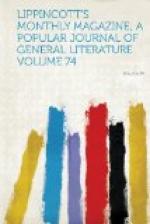“Voyez! Make your choice, brave parents! If the little one pulls in pieces the object of his affection, no matter: it will not derange your resources to replace it.”
Courier, in the preface to his translation of Herodotus, tells us that Malherbe, the courtier, used to say, “I learn all my French at the Place Maubert,” and that Plato, who was a poet and did not like the lower orders, nevertheless called them his “masters of language.” The gamin of Paris, who is the father of argot, long ago gave to the quarter of the city through which the Rue Mouffetard runs a name which clings to it tenaciously. He called it the “quartier souffrant”—the suffering quarter. A designation like this, given by a magazinist, would be fitting enough, certainly, but received into the current slang of Paris, it becomes a really striking phrase. It is nothing to read of a suffering quarter, but it is almost startling to hear an omnibus conductor call out, “Place Maubert! Rue St. Victor! Pantheon! Quartier Souffrant! Anybody for the Suffering Quarter?” and to see a rheumatic old woman, tottering with years and clad in dirty rags, get down and go clattering off into the quarter to which she so palpably belongs.
The Rue Mouffetard, which in old times was a continuation of the Place Maubert from the river Seine, then extended in an unbroken line to the Barriere d’Italie, at the remote southern limit of the city of Paris. The Haussmannizing reform which set in under the Empire went at the horrible neighborhood with a sort of sublime fury of destruction. Whole blocks of dark, forbidding buildings were obliterated by the pickaxes of the blousards, who thus assisted at their own regeneration. The result is, that there is a long and wide avenue now stretching its lines of lamps into the distance from the point where the Rue Mouffetard stops and the Avenue Gobelins begins. The old street—the portion of it which remains—looks with a dazed and dirty sorrowfulness up the broad, clean avenue which once was dirty and narrow like itself. The work of transformation ceased with the breaking out of the war with Germany. So did the like work in numerous other quarters of the town which needed it quite as badly as the Rue Mouffetard. But under the government of the Septennat the work has been resumed in some degree. The double purpose is hereby served of letting in light on the dark spots of the town, and of giving employment to the needy blousards, who might get into obstreperous moods again if crowded too hard by poverty and want. It seems at first sight an awful destruction of property, this work of demolition, but I believe it has been proved that the rise in value of the real estate thus regenerated more than compensates for the losses sustained, in the long run. All the blousard cares about the matter, however, is that it gives him work, and that is what he craves.




